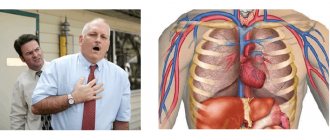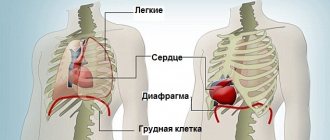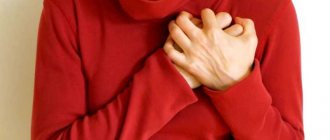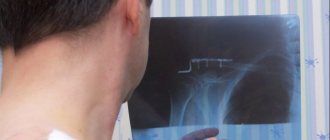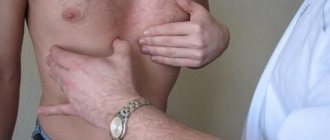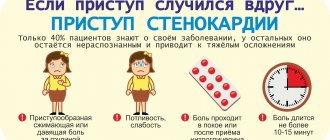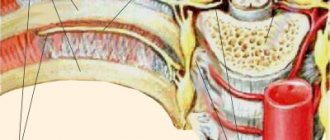Types of pain
The nature of pain in the shoulder blades may vary. Depending on this criterion, it is possible to assume a possible disease and determine the cause of discomfort:
- Shooting, sharp, occurring when turning the body or moving. Characteristic of pinched nerves. This characteristic makes it possible to distinguish it from pain due to cholelithiasis - with this diagnosis, the discomfort is constant and does not depend on movements.
- Cutting, boring pain of varying intensity. May indicate neuralgia, inflammation in the joints.
- Throbbing, aching or burning. Such pain in the area of the shoulder blades indicates diseases of the internal organs. The symptom develops due to compression of the nerve roots and can become more pronounced with movement.
- Stiff pain at or below the shoulder blades. Characteristic of spinal hernia. Often accompanied by numbness of the arms or legs, lumbago.
Main reasons ↑
We list the main diseases that can manifest themselves with this symptom:
- traumatic damage to the constituent structures of the thoracic and cervical spine;
- osteochondrotic changes in the thoracic or cervical spine;
- sideways curvature of the spine (scoliosis);
- kyphosis and kyphoscoliosis;
- spondyloarthrosis;
- intercostal hernia;
- hernia between the thoracic vertebrae;
- glenohumeral periarthrosis;
- intercostal neuralgia;
- herpes zoster and some other infectious diseases;
- heart diseases: coronary disease, myocardial infarction;
- pathology of the mediastinum (organs located between the two lungs);
- diseases of the esophagus, stomach, duodenum;
- diseases of the liver and hepatobiliary system;
- diseases of the lungs and their membranes - the pleura;
- kidney pathology;
- frequent performance of a certain type of action against the background of systemic diseases.
In order to understand at least a little about the huge amount of pathology (to know which doctor to contact), we will break down the main causes of pain according to the characteristics of this pain.
In the chest and between the shoulder blades
This usually looks like this:
- kyphosis (curvature of the spine in the anteroposterior direction, convexity backwards);
- scoliosis;
- intervertebral hernia of the thoracic region.
In this case, the pain is present for a long time, has different severity, is usually absent in the morning, and increases in the evening.
In addition, pain can be a symptom of:
- coronary heart disease: in this case, pain occurs at heights of physical activity; it usually goes away with taking a nitroglycerin tablet;
- cholecystitis: then the pain is associated with eating fatty foods;
- hepatitis: it is also characterized by increased bleeding (for example, after brushing teeth), changes in skin color;
- pneumonia and pleurisy: there will also be a cough, increased body temperature, and signs of intoxication.
When inhaling
The causes of pain between the shoulder blades when inhaling can be:
- Intercostal neuralgia. It has a shooting, encircling character. It intensifies with a deep breath, sudden movement of the body, or when palpating the sore area between the ribs. An increase in temperature is typical if neuralgia is caused by the shingles virus. Then small bubbles with clear liquid will be visible on the skin of the diseased area.
- Lung diseases. In this case, pain between the shoulder blades is also present when inhaling, intensifies with a deep breath and is accompanied by an increase in temperature, most often a cough (the absence of a cough does not indicate the absence of pneumonia), weakness, fatigue, and sometimes nausea and lack of appetite.
If the pain intensifies even when you take a deep breath, and the pain is more likely under the right shoulder blade, we may be talking about a diaphragmatic abscess.
After sleep
This is almost always how cervical osteochondrosis manifests itself if you slept in an uncomfortable position.
The “test” in this case will be increased pain when rotating the head or hyperextending it.
Sharp pain in the spine
This symptom in most cases indicates that there is irritation, pinching or inflammation of the roots of one or more spinal nerves.
Read also…. Right lower back pain
When you turn your head
This is how diseases of the spine (mainly osteochondrosis) manifest themselves at the level of the lower cervical - upper thoracic vertebrae.
This condition is not accompanied by fever, weakness, or loss of appetite.
When tilting your head
This type of pain manifests itself as inflammation of the muscles of the interscapular region, as well as damage to their tendons, ligaments and places of attachment to the vertebrae.
Between the shoulder blades and in the neck
He almost always talks about diseases of the spine (most often degenerative-dystrophic, that is, osteochondrosis, spondyloarthrosis, ankylosing spondylitis).
The pain can be described as either sharp, shooting, or aching. But it should always be associated with movement, intensifying when turning the head, raising the arms, tilting the neck or placing the hands behind the back.
The pain may worsen at night.
During pregnancy
Typically, such pain indicates an increased load on the spine due to a shift in the center of gravity.
But it goes away after rest and is not accompanied by fatigue or increased body temperature.
The latter symptoms, together with interscapular pain syndrome, may indicate pneumonia or pyelonephritis.
After training
This is how pain manifests itself from overload either in the muscles of this area, or in the thoracic (less often, cervical) spine.
In the morning
An aching, dull pain that occurs in the morning and can wake a person up indicates an exacerbation of osteochondrosis.
It is characterized by a decrease in pain when taking a warm bath and applying a warming cream to this area.
An increase in temperature and intoxication symptoms indicate diseases of the internal organs.
When coughing
Typically, pain when coughing is characteristic of intercostal neuralgia.
But it is also characterized by:
- encircling character;
- paroxysmal;
- pain when palpating the intercostal space.
It can radiate to the heart area, to the lower back, under the shoulder blades, which requires additional studies (ultrasound of the abdomen, ECG, X-ray of the lungs) to exclude diseases of the internal organs.
The pain caused by neuralgia intensifies in a certain position of the body, when walking, or physical activity.
After meal
This is how peptic ulcer manifests itself, mainly of the stomach, but sometimes of the duodenum.
Peptic ulcer disease is confirmed by the fact that it becomes easier if you drink Omez or Ranitidine after vomiting, as well as if you apply a warm heating pad to your back.
In addition to pain, this pathology causes heartburn, belching, and nausea.
When swallowing
The connection between pain between the shoulder blades and swallowing requires mandatory consultation with a doctor.
These can be serious diseases such as:
- inflammation or ulcer in the esophagus;
- inflammation of the organs located between the two lungs (mediastinitis);
- disease of the diaphragm (then, in addition to pain when swallowing, the pain syndrome will intensify under such loads when intra-abdominal pressure increases).
Giving into the hand
This is a symptom of osteochondrosis of the cervical or upper thoracic region.
In this case, the pain intensifies with load on the neck or prolonged uncomfortable position. There may also be dizziness and a feeling of “pins and needles” in the arms.
There should be no fever, vomiting, or weakness.
Gives to the neck
This diagnosis is quite complicated.
This symptom can manifest both spinal diseases and life-threatening pathologies:
- Humeroscapular periarthrosis. In this case, pain in the back and arm is associated with certain movements. They are not accompanied by an increase in temperature or a change in the general condition of a person.
- Biliary colic. It occurs due to blockage of the outflow of bile by a stone. The pain is sharp, stabbing. The general condition also suffers.
- Disease of the aorta - aneurysm. It is characterized by pain, which is localized mainly behind the sternum, radiating under the shoulder blade and into the neck.
- Myocardial infarction. It can very rarely manifest itself in the form of not retrosternal, but interscapular pain, radiating to the neck. Often with this life-threatening disease, the pain will be localized behind the sternum, in the shoulder blade, in the left arm, and in the neck.
Fig.: Aortic aneurysm
Giving into the stomach
This is how a peptic ulcer usually manifests itself - the stomach or upper intestine. Accompanied by nausea, belching, heartburn, and a feeling of bloating.
The pain is associated with eating.
After childbirth
Such pain usually indicates the emergence or exacerbation of spinal pathology:
- kyphoscoliosis;
- disc protrusion;
- scoliosis;
- spondyloarthrosis.
Read also…. The joints on the fingers hurt - what to do?
But these problems should not cause loss of consciousness, fever, or deterioration in health.
The child has
Almost always this is a sign of developing scoliosis due to poor posture.
In this case, you can notice that the lower corners of the shoulder blades, as well as the shoulders, are at different levels.
If the pain is associated with eating, there are belchings or heartburn, this may be gastritis or peptic ulcer.
The association of pain with eating fatty foods and a feeling of bloating can indicate both biliary dyskinesia and cholecystitis.
In this and the penultimate case, a visit to a pediatric gastroenterologist should not be postponed.
Survey
To determine the cause of pain in the shoulder blades, patients are prescribed the following diagnostic procedures:
- Clinical tests of blood and urine. They show inflammatory changes and help in the diagnosis of somatic diseases.
- X-ray examination, CT scan. Allows you to detect curvature of the spinal column, injuries and their consequences, osteochondrosis.
- Ultrasound. Used to identify pathologies of internal organs.
- ECG. Informative in case of suspected cardiac diseases.
- MRI. Reflects the condition of the spinal column, shoulder girdle, and internal organs. The area of research is determined by the doctor depending on the expected diagnosis.
Note!
Pain below the shoulder blades often indicates neurological pathologies. Therefore, CT and MRI are the gold standard in determining the cause of the symptom.
Features of treatment
The goal of treatment is not just to relieve pain, but also to eliminate the factor that leads to its occurrence. When seeking medical help, pain relief is simultaneously carried out, as well as etiological treatment aimed at eliminating the underlying disease. The therapeutic program may include the following methods:
- Drug treatment. To relieve pain, drugs from a number of analgesics and anti-inflammatory drugs are used. Depending on the cause of the symptom, antibacterial agents, diuretics, gastroprotectors, etc. can be used.
- Physiotherapy. Helps speed up recovery from somatic pathologies and strengthen the spine. To eliminate pain in the area of the shoulder blades, electrophoresis, shockwave therapy, and warming procedures are used.
- Massage. Helps relieve muscle spasms, improve posture, and relieve pain. Prescribed for problems with the spine. Sometimes intervention by an osteopath or chiropractor is required.
- Gymnastics. Indicated during the recovery period. A set of exercises is selected for each patient individually depending on the established diagnosis.
Which doctor treats chest and back pain?
If there is pain behind the sternum and radiates to the back, you should first consult a general practitioner or family doctor. He will conduct an initial diagnosis and determine which specialist you need to contact. It could be:
- cardiologist;
- traumatologist;
- surgeon;
- oncologist;
- gastroenterologist;
- endocrinologist;
- mammologist;
- pulmonologist
If pain in the sternum is accompanied by high fever, loss of consciousness, prevents you from taking a breath and causes suffocation, you need to call an ambulance.
How to prevent discomfort in the shoulder blade area?
Each patient who has undergone treatment is subsequently recommended to follow a number of preventive measures. They are necessary to prevent relapse of the disease. It is important to follow these rules:
- create favorable conditions for sleep - select an orthopedic pillow and a mattress of moderate hardness to support the physiological position of the spine;
- watch your posture;
- follow the principles of proper nutrition;
- try to prevent exacerbation of chronic pathologies;
- give up bad habits (smoking, drinking alcohol);
- Visit your doctor regularly for preventive examinations.
Pain in the shoulder blade area can be caused by somatic and neurological causes. In the latter case, the symptom occurs abruptly and is pronounced. With a somatic origin, the pain increases gradually and persists for a long time, does not depend on body movements. Analgesics can be used to relieve an unpleasant symptom. However, to completely eliminate pain, it is important to undergo a full course of treatment aimed at getting rid of the underlying pathology. Only a doctor can develop the correct therapeutic course after a complete examination.
Useful video on the topic:


